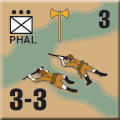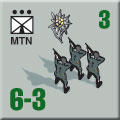La Campagne de Tunisie:
German Pieces
by Mike Bennighof, Ph.D.
December 2022
 While the French Army of Africa (soon to revert to its long-assigned wartime designation of XIX Corps) fought in Tunisia with troops and weapons that had been in place for well over two years, the Germans had to throw together whatever forces they could to mount resistance against the Allied advance. While the French Army of Africa (soon to revert to its long-assigned wartime designation of XIX Corps) fought in Tunisia with troops and weapons that had been in place for well over two years, the Germans had to throw together whatever forces they could to mount resistance against the Allied advance.
The Germans built their new Fifth Panzer Army around the very good 10th Panzer Division, but many of the troops represented whatever could be found and flown or shipped across the Sicilian Channel. Given designer Philippe Léonard’s obsession with strange and unusual weapons, vehicles and units, it was pretty much inevitable that “whatever could be found” would show up in Panzer Grenadier: La Campagne de Tunisie, our French-themed expansion for An Army at Dawn. Let’s have a look at them.
Replacements
 German units flung into Tunisia included hastily-created formations, like the 334th Infantry Division, and odd agglomerations like the 999th Light Afrika Division, a penal unit including many anti-Nazi political prisoners who were overjoyed to have the opportunity to defect to the Americans. They also deployed 24 replacement battalions in the front lines, the equivalent of almost three infantry divisions. German units flung into Tunisia included hastily-created formations, like the 334th Infantry Division, and odd agglomerations like the 999th Light Afrika Division, a penal unit including many anti-Nazi political prisoners who were overjoyed to have the opportunity to defect to the Americans. They also deployed 24 replacement battalions in the front lines, the equivalent of almost three infantry divisions.
The German Army’s replacement system grouped men destined for front-line units into ad-hoc battalions for transport. These temporary organizations oversaw the pay and feeding of the men until they reached their destination, and came under the temporary command of officers and NCO’s similarly destined for the front. The troops had personal weapons and often machine guns, and the battalion had a field kitchen, but otherwise they lacked heavy weapons, communications gear and other accoutrements of war.
The November 1942 Allied invasion of North Africa caught the Germans without ready reinforcements to carry out the occupation of Tunisia. Five replacement battalions had gathered in southern Italy over previous weeks, their transport suspended after the Battle of El Alamein sent Panzer Army Afrika into precipitous retreat, and theater commander Alfred Kesselring ordered them deployed to occupy Tunis. Re-designated T1 through T5, they received lavish allotments of machine guns, anti-tank guns and mortars. Four of them flew into Tunis and Bizerte in the first days of the occupation, while the fifth went to Sfax in southern Tunisia.
The battalions performed surprisingly well, but represented a vast misuse of resources though one typical for the feudal nature of Nazi Germany. Officers and NCO’s came from all service branches – artillery, logistics, communications – and did not necessarily have any infantry experience. Many of the men now thrown into infantry combat had been trained for other specialties. Other line units remained understrength, while the gunners and radiomen they needed toted rifles a few miles away.
Phalange
 Following the Allied landings in November 1942, the Vichy government called for volunteers to fight against the British and Americans. The German ambassador to Vichy had made clear that French Army units would not be allowed to re-deploy from the mainland to Tunisia – the Germans saw no need to supply the Allies with still more troops. Pierre Laval, head of the Vichy government, felt it important to make a gesture showing that the Allies had invaded against the will of the French people. Following the Allied landings in November 1942, the Vichy government called for volunteers to fight against the British and Americans. The German ambassador to Vichy had made clear that French Army units would not be allowed to re-deploy from the mainland to Tunisia – the Germans saw no need to supply the Allies with still more troops. Pierre Laval, head of the Vichy government, felt it important to make a gesture showing that the Allies had invaded against the will of the French people.
It turned out to be a very small gesture. Laval refused the demands of more radical members of his government to declare war on the United States, but did agree to send a volunteer “legion” to fight in Tunisia. The troops would be drawn from those training for service with the small French Volunteer Legion then serving on the Eastern Front, but only sixty men came forward. The Germans approved the transport of fifteen officers, but only six actually made it to Tunisia.
There they joined volunteers from the local French settler community; just how many came forward is subject to dispute but it seems to have numbered between 250 and 450 including about a hundred Arab Tunisians recruited separately by the Germans and transferred to the French volunteer unit, now known as the Phalange Africaine.
The new legion trained at a former French Army barracks and received French uniforms, weapons and equipment. The Germans had to provide rifles, and before the unit went to the front they received German uniforms and helmets with a blue-white-red rosette. For support weapons they had a pair of 60mm mortars and three 47mm anti-tank guns; for some reason the Germans also gave them over a thousand flares.
In early April the Phalange was attached to the 334th Infantry Division’s 754th Grenadier Regiment as Kompagnie Frankonia. The Arab Tunisians were transferred away, and on the night of 8-9 April the French entered the front line facing the British. Their front remained quiet until the 22nd, when a British bombardment and following infantry assault crushed the Phalange. Those not killed, wounded or captured on the spot fled the battlefield.
The Germans disbanded the unit on 6 May but only provided transport out of Tunisia for a handful of officers. The remaining men came under the protection of the Archbishop of Carthage but soon were arrested by the new French regime. Most of the survivors were shot either in May 1943 or after the war, but a few were forcibly incorporated into the Army of Africa and saw action against the Germans in Italy and France.
Mountain Troops
 Destined for frozen Lappland, some troops from the mountain replacement battalions of 2nd Mountain Division ended up being diverted to Tunisia instead. These included actual mountain troops, soon diverted into small battle groups, and the quickly-created 756th Mountain (Gebirgsjäger) Regiment of the 334th Infantry Division. This regiment had a cadre from 2nd Mountain Division’s training establishment, which seems to have used the opportunity to rid itself of unwanted personnel including 1,100 Slovene conscripts who had been declared “Aryan” enough for service and responded by refusing to obey orders even after three of them were shot. The regiment deployed to Africa without the Slovenes, which probably increased its efficiency. Destined for frozen Lappland, some troops from the mountain replacement battalions of 2nd Mountain Division ended up being diverted to Tunisia instead. These included actual mountain troops, soon diverted into small battle groups, and the quickly-created 756th Mountain (Gebirgsjäger) Regiment of the 334th Infantry Division. This regiment had a cadre from 2nd Mountain Division’s training establishment, which seems to have used the opportunity to rid itself of unwanted personnel including 1,100 Slovene conscripts who had been declared “Aryan” enough for service and responded by refusing to obey orders even after three of them were shot. The regiment deployed to Africa without the Slovenes, which probably increased its efficiency.
In La Campagne de Tunisie, the MTN pieces represent the small number of mountain troops, while the 756th “Mountain” Regiment is considered a replacement (Ersatz) unit.
And those are the Germans found in La Campagne de Tunisie.
You can order La Campagne de Tunisie right here.
Sign up for our newsletter right here. Your info will never be sold or transferred; we'll just use it to update you on new games and new offers.
Mike Bennighof is president of Avalanche Press and holds a doctorate in history from Emory University. A Fulbright Scholar and NASA Journalist in Space finalist, he has published a great many books, games and articles on historical subjects; people are saying that some of them are actually good.
He lives in Birmingham, Alabama with his wife and three children. He misses his Iron Dog, Leopold.
Want to keep Daily Content free of third-party ads? You can send us some love (and cash) through this link right here.
|
